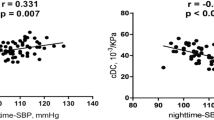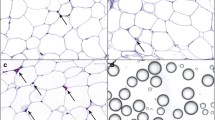Abstract
Subclinical vascular dysfunction is increasingly recognized as an independent risk factor for cardiovascular events and adverse pregnancy outcomes. The evidence linking indices of obesity and vascular dysfunction is mixed. As an example, some data suggest that adiposity may be a better predictor of endothelial dysfunction than body mass index (BMI). The aim of the current study is to compare the association of obesity, as evaluated by BMI, and a direct measure of body fat to biophysical parameters of vascular function including flow-mediated vasodilation and pulse wave velocity (PWV) in healthy nulliparous reproductive-age women. This is a secondary analysis of data collected as a prospective study of prepregnancy physiology in healthy, nulliparous women. Body mass index was calculated as weight (kg)/height (m2). Total and android body fat were calculated by dual-energy X-ray absorptiometry. Brachial PWV and flow-mediated vasodilation were assessed ultrasonographically. Seventy-nine women were evaluated. Mean BMI was 24.4 (5.4) kg/m2, and 15% of women were obese (BMI≥30 kg/m2). In contrast, 39% were considered to have excess adiposity, with ≥ 39% android body fat. Brachial PWV was associated with increased adiposity, but not obesity. We found no differences in flow-mediated dilation associated with either BMI or body fat. Adiposity may be superior to BMI in identifying women with vascular dysfunction at increased risk of adverse pregnancy outcome and cardiovascular disease. Proper identification may allow implementation of prevention strategies to improve perinatal outcomes and maternal health.
Similar content being viewed by others
References
Flegal KM, Kruszon-Moran D, Carroll MD, Fryar CD, Ogden CL. Trends in obesity among adults in the United States, 2005 to 2014. JAMA. 2016;315(21):2284–2291.
Ogden CL, Carroll MD, Kit BK, Flegal KM. Prevalence of childhood and adult obesity in the United States, 2011-2012. JAMA. 2014;311(8):806–814.
Marchi J, Berg M, Dencker A, Olander EK, Begley C. Risks associated with obesity in pregnancy, for the mother and baby: a systematic review of reviews. Obes Rev. 2015;16(8):621–638.
Mission JF, Marshall NE, Caughey AB. Pregnancy risks associated with obesity. Obstet Gynecol Clin North Am. 2015;42(2): 335–353.
Thornburg LL. Antepartum obstetrical complications associated with obesity. Semin Perinatol. 2011;35(6):317–323.
March of Dimes. Preeclampsia. http://www.marchofdimes.org/complications/preeclampsia.aspx. Accessed August 23, 2017.
Cecelja M, Chowienczyk P. Role of arterial stiffness in cardiovascular disease. JRSM Cardiovasc Dis. 2012;1(4).
Sakuragi S, Abhayaratna WP. Arterial stiffness: methods of measurement, physiologic determinants and prediction of cardiovascular outcomes. Int J Cardiol. 2010;138(2):112–118.
Mitchell GF, Hwang SJ, Vasan RS, et al. Arterial stiffness and cardiovascular events: the Framingham Heart Study. Circulation. 2010;121(4):505–511.
Najjar SS, Scuteri A, Shetty V, et al. Pulse wave velocity is an independent predictor of the longitudinal increase in systolic blood pressure and of incident hypertension in the Baltimore Longitudinal Study of Aging. J Am Coll Cardiol. 2008;51(14): 1377–1383.
Vlachopoulos C, Aznaouridis K, Stefanadis C. Prediction of cardiovascular events and all-cause mortality with arterial stiffness: a systematic review and meta-analysis. J Am Coll Cardiol. 2010; 55(13):1318–1327.
Wohlfahrt P, Somers VK, Cifkova R, et al. Relationship between measures of central and general adiposity with aortic stiffness in the general population. Atherosclerosis. 2014;235(2):625–631.
Hale SA, Badger GJ, McBride C, Magness R, Bernstein IM. Prepregnancy vascular dysfunction in women who subsequently develop hypertension during pregnancy. Pregnancy Hypertens. 2013;3(2):140–145.
Khalil A, Garcia-Mandujano R, Maiz N, Elkhouli M, Nicolaides KH. Longitudinal changes in maternal hemodynamics in a population at risk for pre-eclampsia. Ultrasound Obstet Gynecol. 2014; 44(2):197–204. Phillips et al 913
van der Graaf AM, Paauw ND, Toering TJ, et al. Impaired sodium-dependent adaptation of arterial stiffness in formerly preeclamptic women: the RETAP-vascular study. Am J Physiol Heart Circ Physiol. 2016;310(11):H1827-H1833.
Ras RT, Streppel MT, Draijer R, Zock PL. Flow-mediated dilation and cardiovascular risk prediction: a systematic review with meta-analysis. Int J Cardiol. 2013;168(1):344–351.
Inaba Y, Chen JA, Bergmann SR. Prediction of future cardiovascular outcomes by flow-mediated vasodilatation of brachial artery: a meta-analysis. Int J Cardiovasc Imaging. 2010;26(6):631–640.
Weissgerber TL, Milic NM, Milin-Lazovic JS, Garovic VD. Impaired flow-mediated dilation before, during, and after preeclampsia: a systematic review and meta-analysis. Hypertension. 2016;67(2):415–423.
Sutton-Tyrrell K, Newman A, Simonsick EM, et al. Aortic stiffness is associated with visceral adiposity in older adults enrolled in the study of health, aging, and body composition. Hypertension. 2001;38(3):429–433.
Oren A, Vos LE, Uiterwaal CS, Grobbee DE, Bots ML. Aortic stiffness and carotid intima-media thickness: two independent markers of subclinical vascular damage in young adults? Eur J Clin Invest. 2003;33(11):949–954.
Rodrigues SL, Baldo MP, Lani L, Nogueira L, Mill JG, Sa Cunha Rd. Body mass index is not independently associated with increased aortic stiffness in a Brazilian population. Am J Hypertens. 2012;25(10):1064–1069.
Nazare JA, Smith J, Borel AL, et al. Usefulness of measuring both body mass index and waist circumference for the estimation of visceral adiposity and related cardiometabolic risk profile (from the INSPIREME IAA study). Am J Cardiol. 2015;115(3):307–315.
Rees E, Coulson R, Dunstan F, et al. Central arterial stiffness and diastolic dysfunction are associated with insulin resistance and abdominal obesity in young women but polycystic ovary syndrome does not confer additional risk. Hum Reprod. 2014; 29(9):2041–2049.
Strasser B, Arvandi M, Pasha EP, Haley AP, Stanforth P, Tanaka H. Abdominal obesity is associated with arterial stiffness in middle-aged adults. Nutr Metab Cardiovasc Dis. 2015;25(5): 495–502.
World Health Organization. 2016. https://www.nhlbi.nih.gov/health/educational/lose_wt/BMI/bmicalc.htm. Accessed August 23, 2017.
Gallagher D, Heymsfield SB, Heo M, Jebb SA, Murgatroyd PR, Sakamoto Y. Healthy percentage body fat ranges: an approach for developing guidelines based on body mass index. Am J Clin Nutr. 2000;72(3):694–701.
Hale SA, Schonberg A, Badger GJ, Bernstein IM. Relationship between prepregnancy and early pregnancy uterine blood flow and resistance index. Reprod Sci. 2009;16(11):1091–1096.
Morris EA, Hale SA, Badger GJ, Magness RR, Bernstein IM. Pregnancy induces persistent changes in vascular compliance in primiparous women. Am J Obstet Gynecol. 2015;212(5):633. e631-e636.
Clapp Iii MDJF, Capeless Md E. Cardiovascular function before, during, and after the first and subsequent pregnancies. Am J Cardiol. 1997;80(11):1469–1473.
Sutton-Tyrrell K, Najjar SS, Boudreau RM, et al. Elevated aortic pulse wave velocity, a marker of arterial stiffness, predicts cardiovascular events in well-functioning older adults. Circulation. 2005;111(25):3384–3390.
Ohnishi H, Saitoh S, Takagi S, et al. Pulse wave velocity as an indicator of atherosclerosis in impaired fasting glucose: the Tanno and Sobetsu study. Diabetes Care. 2003;26(2):437–440.
Oliveros E, Somers VK, Sochor O, Goel K, Lopez-Jimenez F. The concept of normal weight obesity. Prog Cardiovasc Dis. 2014; 56(4):426–433.
Lavie CJ, Messerli FH. Cardiovascular adaptation to obesity and hypertension. Chest. 1986;90(2):275–279.
Martin BJ, Verma S, Charbonneau F, Title LM, Lonn EM, Anderson TJ. The relationship between anthropometric indexes of adiposity and vascular function in the FATE cohort. Obesity (Silver Spring). 2013;21(2):266–273.
Meyers MR, Gokce N. Endothelial dysfunction in obesity: etiological role in atherosclerosis. Curr Opin Endocrinol Diabetes Obes. 2007;14(5):365–369.
Pulerwitz T, Grahame-Clarke C, Rodriguez CJ, et al. Association of increased body mass index and impaired endothelial function among Hispanic women. Am J Cardiol. 2006;97(1):68–70.
Williams IL, Chowienczyk PJ, Wheatcroft SB, et al. Effect of fat distribution on endothelial-dependent and endothelialindependent vasodilatation in healthy humans. Diabetes Obes Metab. 2006;8(3):296–301.
Benjamin EJ, Larson MG, Keyes MJ, et al. Clinical correlates and heritability of flow-mediated dilation in the community: the Framingham Heart Study. Circulation. 2004;109(5):613–619.
Brook RD, Bard RL, Rubenfire M, Ridker PM, Rajagopalan S. Usefulness of visceral obesity (waist/hip ratio) in predicting vascular endothelial function in healthy overweight adults. Am J Cardiol. 2001;88(11):1264–1269.
Okorodudu DO, Jumean MF, Montori VM, et al. Diagnostic performance of body mass index to identify obesity as defined by body adiposity: a systematic review and meta-analysis. Int J Obes (Lond). 2010;34(5):791–799.
Buckinx F, Reginster JY, Dardenne N, et al. Concordance between muscle mass assessed by bioelectrical impedance analysis and by dual energy X-ray absorptiometry: a cross-sectional study. BMC Musculoskelet Disord. 2015;16:60.
Hangartner TN, Warner S, Braillon P, Jankowski L, Shepherd J. The Official Positions of the International Society for Clinical Densitometry: acquisition of dual-energy X-ray absorptiometry body composition and considerations regarding analysis and repeatability of measures. J Clin Densitom. 2013;16(4):520–536.
Laskey MA. Dual-energy X-ray absorptiometry and body composition. Nutrition. 1996;12(1):45–51.
Pateyjohns IR, Brinkworth GD, Buckley JD, Noakes M, Clifton PM. Comparison of three bioelectrical impedance methods with DXA in overweight and obese men. Obesity (Silver Spring). 2006; 14(11):2064–2070.
Rothney MP, Xia Y, Wacker WK, et al. Precision of a new tool to measure visceral adipose tissue (VAT) using dual-energy X-ray absorptiometry (DXA). Obesity (Silver Spring). 2013;21(1): E134–E136.
LaForgia J, Dollman J, Dale MJ, Withers RT, Hill AM. Validation of DXA body composition estimates in obese men and women. Obesity (Silver Spring). 2009;17(4):821–826.
Thibault R, Pichard C. The evaluation of body composition: a useful tool for clinical practice. Ann Nutr Metab. 2012;60(1): 6–16.
Wells JC, Fewtrell MS. Measuring body composition. Arch Dis Child. 2006;91(7):612–617.
Franklin SS. Beyond blood pressure: arterial stiffness as a new biomarker of cardiovascular disease. J Am Soc Hypertens. 2008; 2(3):140–151.
Franz MB, Burgmann M, Neubauer A, et al. Augmentation index and pulse wave velocity in normotensive and preeclamptic pregnancies. Acta Obstet Gynecol Scand. 2013; 92(8):960–966.
Hamad RR, Eriksson MJ, Silveira A, Hamsten A, Bremme K. Decreased flow-mediated dilation is present 1 year after a preeclamptic pregnancy. J Hypertens. 2007;25(11):2301–2307.
Orabona R, Sciatti E, Vizzardi E, et al. Endothelial dysfunction and vascular stiffness in women with previous pregnancy complicated by early or late pre-eclampsia. Ultrasound Obstet Gynecol. 2017;49(1):116–123.
Hausvater A, Giannone T, Sandoval YH, et al. The association between preeclampsia and arterial stiffness. J Hypertens. 2012; 30(1):17–33.
Christensen M, Kronborg CS, Eldrup N, Rossen NB, Knudsen UB. Preeclampsia and cardiovascular disease risk assessment— do arterial stiffness and atherosclerosis uncover increased risk ten years after delivery?. Pregnancy Hypertens. 2016;6(2):110–114.
Ostlund E, Al-Nashi M, Hamad RR, et al. Normalized endothelial function but sustained cardiovascular risk profile 11 years following a pregnancy complicated by preeclampsia. Hypertens res. 2013;36(12):1081–1087.
Zhang C, Rexrode KM, van Dam RM, Li TY, Hu FB. Abdominal obesity and the risk of all-cause, cardiovascular, and cancer mortality: sixteen years of follow-up in US women. Circulation. 2008;117(13):1658–1667.
Bellamy L, Casas JP, Hingorani AD, Williams DJ. Pre-eclampsia and risk of cardiovascular disease and cancer in later life: systematic review and meta-analysis. BMJ. 2007;335(7627):974.
Author information
Authors and Affiliations
Corresponding author
Rights and permissions
About this article
Cite this article
Phillips, J., McBride, C.A., Morris, E. et al. Adiposity, but not Obesity, Is Associated With Arterial Stiffness in Young Nulliparous Women. Reprod. Sci. 25, 909–915 (2018). https://doi.org/10.1177/1933719117728797
Published:
Issue Date:
DOI: https://doi.org/10.1177/1933719117728797




